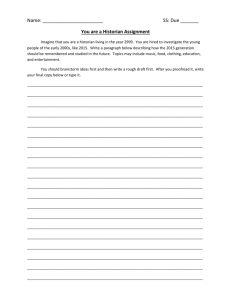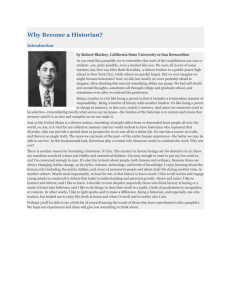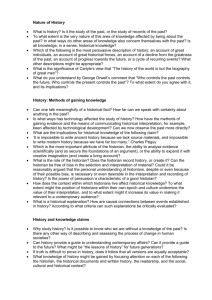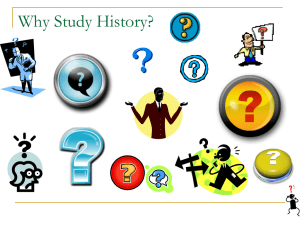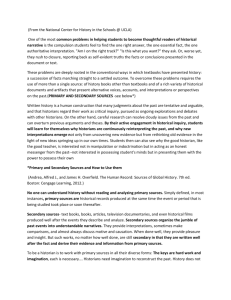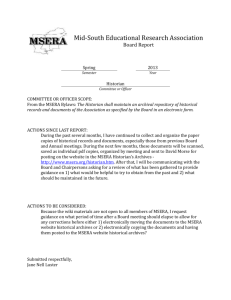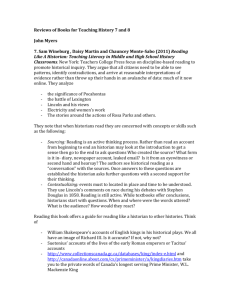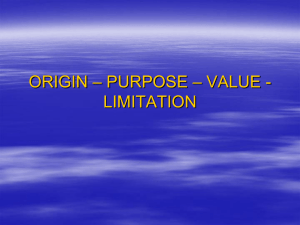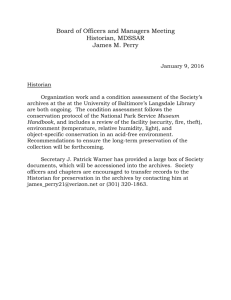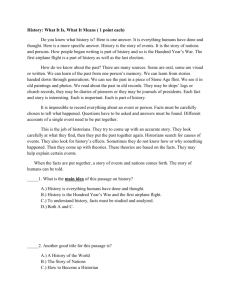History Standard Four: Students will develop historical knowledge of
advertisement
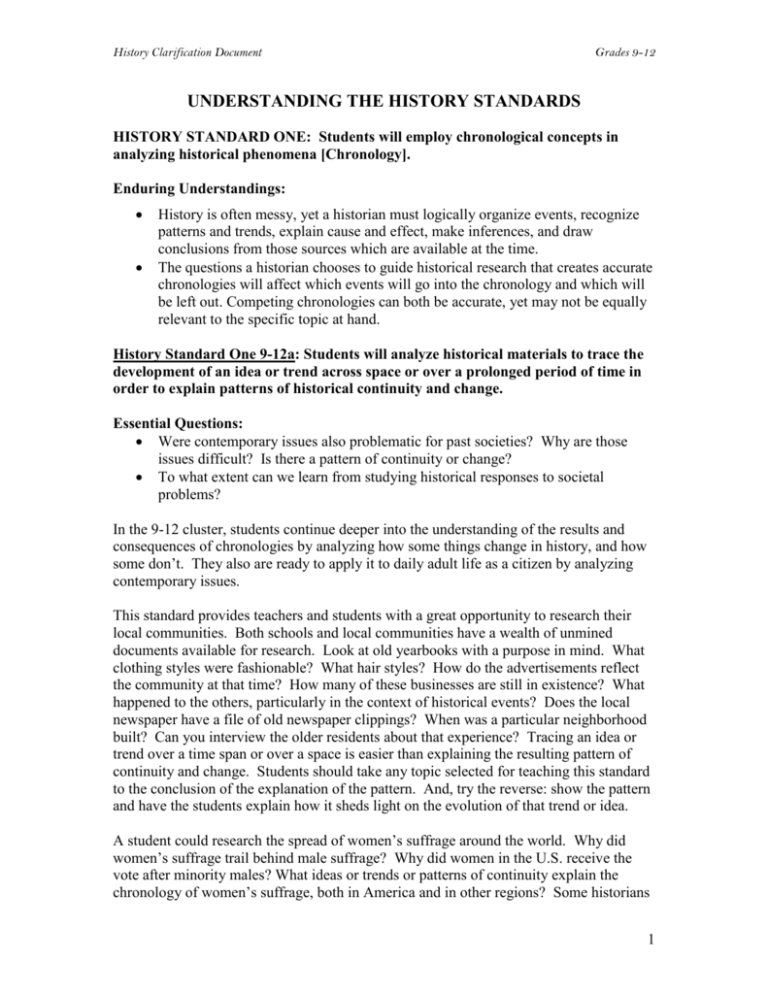
History Clarification Document Grades 9-12 UNDERSTANDING THE HISTORY STANDARDS HISTORY STANDARD ONE: Students will employ chronological concepts in analyzing historical phenomena [Chronology]. Enduring Understandings: History is often messy, yet a historian must logically organize events, recognize patterns and trends, explain cause and effect, make inferences, and draw conclusions from those sources which are available at the time. The questions a historian chooses to guide historical research that creates accurate chronologies will affect which events will go into the chronology and which will be left out. Competing chronologies can both be accurate, yet may not be equally relevant to the specific topic at hand. History Standard One 9-12a: Students will analyze historical materials to trace the development of an idea or trend across space or over a prolonged period of time in order to explain patterns of historical continuity and change. Essential Questions: Were contemporary issues also problematic for past societies? Why are those issues difficult? Is there a pattern of continuity or change? To what extent can we learn from studying historical responses to societal problems? In the 9-12 cluster, students continue deeper into the understanding of the results and consequences of chronologies by analyzing how some things change in history, and how some don’t. They also are ready to apply it to daily adult life as a citizen by analyzing contemporary issues. This standard provides teachers and students with a great opportunity to research their local communities. Both schools and local communities have a wealth of unmined documents available for research. Look at old yearbooks with a purpose in mind. What clothing styles were fashionable? What hair styles? How do the advertisements reflect the community at that time? How many of these businesses are still in existence? What happened to the others, particularly in the context of historical events? Does the local newspaper have a file of old newspaper clippings? When was a particular neighborhood built? Can you interview the older residents about that experience? Tracing an idea or trend over a time span or over a space is easier than explaining the resulting pattern of continuity and change. Students should take any topic selected for teaching this standard to the conclusion of the explanation of the pattern. And, try the reverse: show the pattern and have the students explain how it sheds light on the evolution of that trend or idea. A student could research the spread of women’s suffrage around the world. Why did women’s suffrage trail behind male suffrage? Why did women in the U.S. receive the vote after minority males? What ideas or trends or patterns of continuity explain the chronology of women’s suffrage, both in America and in other regions? Some historians 1 History Clarification Document Grades 9-12 see Manifest Destiny before the Civil War and the imperialism of the Spanish-American War as two versions of the same thrust, the American desire to grab territory at the expense of weaker nations. Or were the two periods different? Or, were neither one primarily characterized by territory grabbing? Some ideas seem to only fit into a particular time or are only applicable to a particular place, such as imperialism or the Enlightenment or the Reformation. Further complicating this standard is the possibility that continuity is more present than change. A Roman Catholic visiting a Lutheran Church will see much that is familiar. Martin Luther kept more than he changed. So, how “revolutionary” was the Reformation? Other examples of this benchmark in history are the following: 1. What factors explain the migration within the United States of population from the Frostbelt or Rustbelt to the Sunbelt? Were the attractions of retirement communities the only explanation? 2. In the years prior to the Civil War, industrialization created a separation between work and the home. Increasingly one worked away from where one lived. As incomes rose for a segment of the population, a self-identified grouping emerged, the middle class, with created cultural and social and family characteristics. This gradual change in social status has long captivated historians because it requires research in non-traditional records. One does not go to the national archives to research family history on a large scale. 3. Notice also the slow emergence of new consumer groups. Teenagers did not suddenly appear in the 1950s. What happened was that business (Hollywood and the record industry, primarily) discovered the existence of a new and large group of consumers and catered to, or created, depending on how cynical your viewpoint is, their subculture, sometimes reflecting their culture and sometimes creating their culture. American Bandstand was the forerunner of MTV, from one show in the afternoon to whole channels now! HISTORY STANDARD TWO: Students will gather, examine, and analyze historical data [Analysis]. Enduring Understandings: Many different types of sources exist to help us gather information about the past, such as artifacts and documents. Sources about the past need to be critically analyzed and categorized as they are used. Critical investigation demands constant reassessment of one’s research strategies. A historian must prove where the information can be found that is the basis for historical conclusions. History Standard Two 9-12a: Students will develop and implement effective research strategies for investigating a given historical topic. History Standard Two 9-12b: Students will examine and analyze primary and secondary sources in order to differentiate between historical facts and historical interpretations. 2 History Clarification Document Grades 9-12 Essential Questions: What is the evidence for this argument? Is that all the evidence, or just what the author wanted me to read? Does differentiating between fact and interpretation matter? Like the previous grade cluster, these benchmarks are also closely linked. Students continue to master a deeper understanding of the use of documents and artifacts and how historians use them to conduct research and to draw conclusions. The individual questions a researcher asks become part of an overall strategy of research -- the problem of where and how to find the answers. Teachers should ask students to develop research strategies, given a particular historical problem, and examine the difficulties inherent in some research. Sources have to exist to be researched; dialogue between two historical figures can’t be replayed without someone present recording what was said. When this standard is fully mastered, a student is ready to apply it in his/her daily adult life as a citizen by critically examining the documentary evidence put forth to support a point of view or assertion. In addition, a citizen needs to ask questions of the person who advocates a particular position. Where did they get their information? What factors influenced their point of view? How much is based on facts and how much is based upon interpretation? An understanding of the role of documentary support behind an assertion is essential for future citizenship. Historical sources can be used to see where a historian strays from his/her sources and injects an interpretation not based upon the sources. By this point, students clearly understand primary and secondary sources and how to critically examine them. Now the standard adds the idea that sources can be used in many ways, some of which, while not strictly dishonest, are clearly opinioned conclusions rather than facts based upon documents. A historian can stray from the sources and interject an interpretation not based upon the sources. At the prior cluster, 6-8, students learned that a researcher needs to be skeptical of every document. Now students learn that while reading what a historian writes we must be skeptical of his/her use of the sources. When does the historian base their argument solidly upon sources and when does the historian express an interpretation based upon their overall research on that topic? One must not be so critical of historians at this point. Sometimes interpretation is the only way to fill in a period or description of something for which there are no documents. But, a person reading the historian’s account must be aware that it is interpretation. HISTORY STANDARD THREE: Students will interpret historical data [Interpretation]. Enduring Understandings: What is written by a historian depends upon that historian’s personal background and methods, the questions asked about the sources, and the sources used to find the answers to those questions. 3 History Clarification Document Grades 9-12 Historians select important events from the past they consider worthy of being taught to the next generation. That selection process, deciding what to emphasize, and the questions that historians ask of the documents and other evidence, contributes significantly to the conclusions drawn. History is what the historian says it is. Historians may collect, use, and emphasize sources in ways that result in differing interpretations as they describe, compare, and interpret historical phenomena. Disagreement between historians about the causes and effects of historical events may result from these differences. History Standard Three 9-12a: Students will compare competing historical narratives, by contrasting different historian’s choice of questions, use and choice of sources, perspectives, beliefs, and points of view, in order to demonstrate how these factors contribute to different interpretations. Essential Questions: Does the way research is conducted matter? To what degree is historical investigation about the historian as much as the history? Is it necessary to include an investigation of the writer in regard to what we read? Is there such a thing as completely unbiased history? In the 9-12 cluster, History Standard Three introduces students to the concept that historical accounts of the same event may differ because of research design decisions made by a historian and because of a historian’s personal background. In cluster 6-8, students learned that the questions asked and how sources were used greatly influenced the historian’s perspective. But there is more. What forces molded and shaped that historian? What did he/she live through? What were the major ideas floating in the air when they grew to intellectual maturity? It is almost impossible for us to imagine today, but in the Great Depression of the 1930s many people came to believe that capitalism had failed and could never be revived. Therefore, modern man faced two choices, fascism or communism, the only two -isms that had a chance to continue. Many intellectuals acquired a bias in favor of fascism or communism during the 1930s which influenced their later research and writing. For example, since communism was considered such a horrible threat to our society, leaders were justified in restricting civil liberties to make certain we will win in the long run. A historian writing about McCarthyism might approach it from either side -- in favor of restricting or defending those civil liberties. The student gains great insight from becoming aware of what could have influenced that historian. Another example: Historians’ accounts of slavery and the antebellum South that were written during the 1950s and 1960s were greatly shaped by the civil rights movement and the perspectives acquired by it. History Standard Four: Students will develop historical knowledge of major events and phenomena in world, United States, and Delaware history [Content]. In a strict sense, Standard Four [Content] is not tested by the Delaware Student Testing Program. The students will not be expected to recall any particular specific event or 4 History Clarification Document Grades 9-12 person in history. But, they will need to know chronology in broad outlines, and enough trends in history that they have a reservoir of information that they can use to provide factual support and examples in their short answers. In short, students have to have an understanding of trends and patterns in order to use that understanding as evidence when drawing conclusions or making inferences. For example, a student responding to a historian’s writing published in the 1950s should be aware that the 1950s came after the Second World War or during the Cold War or during the beginning of a Civil Rights movement. Consider these two sentences the student might write: “He wrote this because Americans were angry at Russia” or “This historian was influenced by the Cold War then taking place between the United States and the Soviet Union.” Obviously the second sentence is much stronger and reflects more understanding. Teachers should not be concerned as they examine the content descriptions in Standard Four for each grade cluster and think, “That’s too much. I could never do that in a school year.” Actually, it is too much to cover, and becomes more ponderous with each passing year. What teachers, schools, and districts must learn to do is selectively abandon certain topics in the course of history. Don’t try to cover everything. It is impossible. Adopt an approach that could be called “post-holing.” Dig deeply into some topics rather than trying to “cover” everything. It is better for a student to clearly understand a concept and to be able to use something in history in an explanation than it is to have a limited understanding of a concept and know a lot of “somethings” in history. Students understand a standard when they can apply it in a new or different situation. The teacher does not have to “cover” every potential situation for the student to be prepared. The student who can apply understanding to a new situation is well equipped for the DSTP, and for life after school. Social Studies content should be about: Themes, broad historical trends, and topics that allow the four strands of the social studies to be integrated and provide a cultural context for the student; Relevant and important contemporary issues; Resources for education and not the scope and sequence contained in a textbook. Select historical topics which are transferable, relevant, integrated, contemporary, and important. Students should study what resonates throughout history and prepares them for decisions they will face as adult citizens. 5
